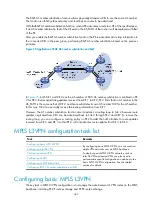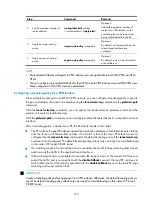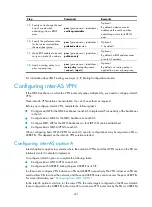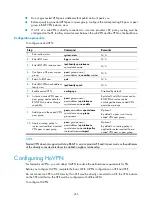
252
Configuring an LDP instance
LDP instances are for carrier's carrier network applications.
This task is to configure the LDP capability for an existing VPN instance, create an LDP instance for the
VPN instance, and configure LDP parameters for the LDP instance.
To configure an LDP instance:
Step Command
Remarks
1.
Enter system view.
system-view
N/A
2.
Enable LDP for a VPN
instance, create an LDP
instance, and enter MPLS LDP
VPN instance view.
mpls ldp
vpn-instance
vpn-instance-name
Disabled by default.
3.
Configure LDP parameters
except LDP GR for the
instance.
For configuration information, see
"
."
Optional.
Except the command for LDP GR, all commands available in MPLS LDP view can be configured in MPLS
LDP VPN instance view. For more information about MPLS LDP, see "
Configurations in MPLS LDP VPN instance view affect only the LDP-enabled interface bound to the VPN
instance. Configurations in MPLS LDP view do not affect interfaces bound to VPN instances. When
configuring the transport address of an LDP instance, use the IP address of the interface bound to the
VPN instance.
By default, LDP adjacencies on a private network are established by using the addresses of the
LDP-enabled interfaces, and those on the public network are established by using the LDP LSR ID.
Configuring routing between PE and CE
You can configure static routing, RIP, OSPF, IS-IS, EBGP, or IBGP between PE and CE.
Before you configure routing between PE and CE, complete the following tasks:
•
Assign an IP address to the CE-PE interface of the CE.
•
Assign an IP address to the PE-CE interface of the PE.
To configure static routing between PE and CE:
Step Command
Remarks
1.
Enter system view.
system-view
N/A






























